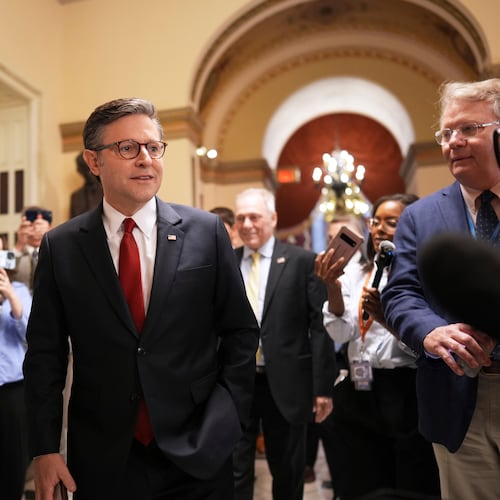MARTA officials approved Thursday the blueprint that will guide Atlanta’s largest transit expansion in decades.
In a 10-0 vote, the MARTA Board of Directors adopted the final version of the transit agency’s “More MARTA” plan, which will distribute $2.7 billion in city of Atlanta projects.
This version differs significantly from the original, much-debated plan presented in May, but mirrors an adjusted set of recommendations presented last week. It includes a larger allocation for transit along the Atlanta Beltline and less funding for the so-called Clifton Corridor. It also includes light rail service, and not the originally proposed bus rapid transit system, along Campbellton Road.
“This is an important day in the history of Atlanta, and a particularly important day for the story of MARTA,” said Robbie Ashe, the MARTA board executive director. “But it is not the end of the discussion.”
In all, the 40-year plan involves 29 miles of light rail, 13 miles of bus rapid transit lines and three arterial rapid transit routes. Station improvements are included as well.
“As Atlanta’s population grows, so must our investment in equitable and accessible transportation options,” Atlanta Mayor Keisha Lance Bottoms said in a written statement Thursday. “With development plans spanning from Greenbriar in Southwest Atlanta to Emory University, today’s MARTA vote helps move us closer towards becoming One Atlanta.”
Atlanta voters approved an additional half-penny sales tax to fund transit construction and operations inside the city in 2016. Atlanta’s City Council compiled a list containing more than $11.5 billion in potential projects, despite the the fact that the tax is expected to collect less than a quarter of that amount.
The agency solicited public input on how to best spend the money — and quickly found that many community groups had many different priorities.
A group called Beltline Rail Now, for instance, lobbied for full funding for light rail around the entire 22-mile trail loop.
Others argued against the Clifton Corridor line, which would connect Emory University area to the larger system. Emory University was recently annexed into Atlanta, they argued, and was not part of the city when voters approved the new sales tax.
The new plan moved toward better appeasing both groups, as well as those who thought adding bus rapid transit service to the Campbellton Road area in southwest Atlanta wasn’t enough. But it will ultimately rely on federal funding and private partners to complete many of the high-profile projects included.
On the Beltline, for example, $174 million in funding is identified to build three miles of light rail from Ponce City Market to MARTA’s existing Lindbergh Station. Another $196 million is identified for four miles of light rail along the Southwest Trail, from the I-20 area to MARTA’s Oakland City station.
But only another $200 million is identified to complete another eight miles of rail along eastern, southeastern and western segments of the Beltline.
“I just want to thank you all for listening, for facilitating the conversations with citizens, and adding more money to transit on the Beltline,” former Atlanta City Council President Cathy Woolard, a Beltline advocate, said at Thursday’s board meeting. “When we started this we felt like we were going to blow a once-in-a-lifetime chance.”
The plan also cut the funding allocated to the Clifton Corridor — which is about four miles of light rail — to $350 million. About $100 million of that is contingent upon finding other local financial support.
Other notable projects in the plan include a $311 million light rail line along Campbellton Road, between the Oakland City MARTA station and Greenbriar Mall. That project was originally slated to start out as a less expensive bus rapid transit route.
Also included is the expansion of the oft-maligned Atlanta Streetcar three miles west from downtown to the Atlanta University Center and to the Beltline’s Westside Trail ($318 million), as well as expanding it two miles east to Krog Street and to the Beltline’s Eastside Trail ($235 million).
Ashe said officials know that there remain a lot of unmet desires, both in Atlanta and elsewhere.
“Over the decades there have been fights to keep transit out of pieces of the region,” Ashe said. “We’re no longer having that fight. … Now the fight is why isn’t transit in my community and why isn’t it there soon enough.”
Clayton County voted to join MARTA in 2014 and is exploring its high-capacity options. DeKalb County has embarked upon a transit study and is likely to expand its offerings in the future. Cobb County is considering, among other things, holding a referendum on joining the recently created regional transit authority called The ATL.
The ATL's board, which will be tasked with helping guide the creation of a more seamless regional transit system, is expected to be formed by the start of 2019.
The Atlanta plan's approval also comes less than a month after the MARTA board voted to enter a historic contract with Gwinnett County. That contract, which would include extending heavy rail into the suburban county, is still dependent on the outcome of a March referendum by Gwinnett voters.
WHAT’S NEXT
• MARTA CEO Jeffrey Parker said the agency will now work on a plan for prioritizing the projects. That plan could be presented to the board in a few months.
• That plan, which will be based on things like complexity and environmental studies, will determine the schedule for when certaint projects are built.
• Parker said light rail projects could take 7 to 10 years to be up and running. Bus rapid transit lines could be in place within two or three years.
• MARTA will also be focused on helping secure additional funding.
About the Author
Keep Reading
The Latest
Featured





